Bharat Lal Bhatnagar
GEARS: Local Geometry-aware Hand-object Interaction Synthesis
Apr 04, 2024Abstract:Generating realistic hand motion sequences in interaction with objects has gained increasing attention with the growing interest in digital humans. Prior work has illustrated the effectiveness of employing occupancy-based or distance-based virtual sensors to extract hand-object interaction features. Nonetheless, these methods show limited generalizability across object categories, shapes and sizes. We hypothesize that this is due to two reasons: 1) the limited expressiveness of employed virtual sensors, and 2) scarcity of available training data. To tackle this challenge, we introduce a novel joint-centered sensor designed to reason about local object geometry near potential interaction regions. The sensor queries for object surface points in the neighbourhood of each hand joint. As an important step towards mitigating the learning complexity, we transform the points from global frame to hand template frame and use a shared module to process sensor features of each individual joint. This is followed by a spatio-temporal transformer network aimed at capturing correlation among the joints in different dimensions. Moreover, we devise simple heuristic rules to augment the limited training sequences with vast static hand grasping samples. This leads to a broader spectrum of grasping types observed during training, in turn enhancing our model's generalization capability. We evaluate on two public datasets, GRAB and InterCap, where our method shows superiority over baselines both quantitatively and perceptually.
FORCE: Dataset and Method for Intuitive Physics Guided Human-object Interaction
Mar 17, 2024
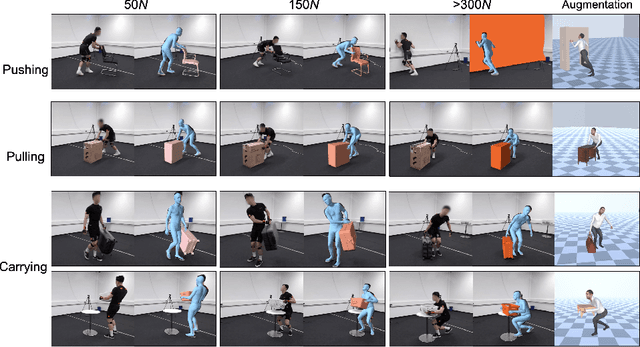

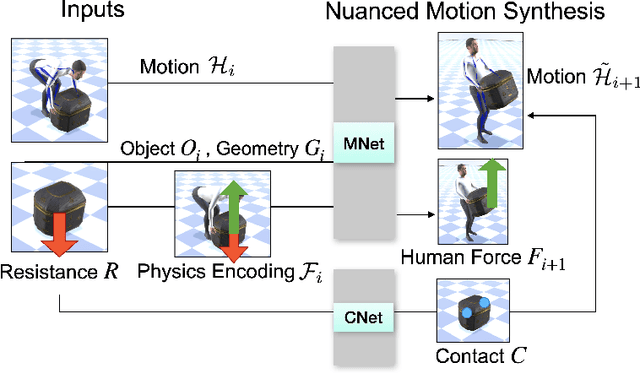
Abstract:Interactions between human and objects are influenced not only by the object's pose and shape, but also by physical attributes such as object mass and surface friction. They introduce important motion nuances that are essential for diversity and realism. Despite advancements in recent kinematics-based methods, this aspect has been overlooked. Generating nuanced human motion presents two challenges. First, it is non-trivial to learn from multi-modal human and object information derived from both the physical and non-physical attributes. Second, there exists no dataset capturing nuanced human interactions with objects of varying physical properties, hampering model development. This work addresses the gap by introducing the FORCE model, a kinematic approach for synthesizing diverse, nuanced human-object interactions by modeling physical attributes. Our key insight is that human motion is dictated by the interrelation between the force exerted by the human and the perceived resistance. Guided by a novel intuitive physics encoding, the model captures the interplay between human force and resistance. Experiments also demonstrate incorporating human force facilitates learning multi-class motion. Accompanying our model, we contribute the FORCE dataset. It features diverse, different-styled motion through interactions with varying resistances.
RoHM: Robust Human Motion Reconstruction via Diffusion
Jan 16, 2024



Abstract:We propose RoHM, an approach for robust 3D human motion reconstruction from monocular RGB(-D) videos in the presence of noise and occlusions. Most previous approaches either train neural networks to directly regress motion in 3D or learn data-driven motion priors and combine them with optimization at test time. The former do not recover globally coherent motion and fail under occlusions; the latter are time-consuming, prone to local minima, and require manual tuning. To overcome these shortcomings, we exploit the iterative, denoising nature of diffusion models. RoHM is a novel diffusion-based motion model that, conditioned on noisy and occluded input data, reconstructs complete, plausible motions in consistent global coordinates. Given the complexity of the problem -- requiring one to address different tasks (denoising and infilling) in different solution spaces (local and global motion) -- we decompose it into two sub-tasks and learn two models, one for global trajectory and one for local motion. To capture the correlations between the two, we then introduce a novel conditioning module, combining it with an iterative inference scheme. We apply RoHM to a variety of tasks -- from motion reconstruction and denoising to spatial and temporal infilling. Extensive experiments on three popular datasets show that our method outperforms state-of-the-art approaches qualitatively and quantitatively, while being faster at test time. The code will be available at https://sanweiliti.github.io/ROHM/ROHM.html.
RHOBIN Challenge: Reconstruction of Human Object Interaction
Jan 07, 2024Abstract:Modeling the interaction between humans and objects has been an emerging research direction in recent years. Capturing human-object interaction is however a very challenging task due to heavy occlusion and complex dynamics, which requires understanding not only 3D human pose, and object pose but also the interaction between them. Reconstruction of 3D humans and objects has been two separate research fields in computer vision for a long time. We hence proposed the first RHOBIN challenge: reconstruction of human-object interactions in conjunction with the RHOBIN workshop. It was aimed at bringing the research communities of human and object reconstruction as well as interaction modeling together to discuss techniques and exchange ideas. Our challenge consists of three tracks of 3D reconstruction from monocular RGB images with a focus on dealing with challenging interaction scenarios. Our challenge attracted more than 100 participants with more than 300 submissions, indicating the broad interest in the research communities. This paper describes the settings of our challenge and discusses the winning methods of each track in more detail. We observe that the human reconstruction task is becoming mature even under heavy occlusion settings while object pose estimation and joint reconstruction remain challenging tasks. With the growing interest in interaction modeling, we hope this report can provide useful insights and foster future research in this direction. Our workshop website can be found at \href{https://rhobin-challenge.github.io/}{https://rhobin-challenge.github.io/}.
Template Free Reconstruction of Human-object Interaction with Procedural Interaction Generation
Dec 12, 2023Abstract:Reconstructing human-object interaction in 3D from a single RGB image is a challenging task and existing data driven methods do not generalize beyond the objects present in the carefully curated 3D interaction datasets. Capturing large-scale real data to learn strong interaction and 3D shape priors is very expensive due to the combinatorial nature of human-object interactions. In this paper, we propose ProciGen (Procedural interaction Generation), a method to procedurally generate datasets with both, plausible interaction and diverse object variation. We generate 1M+ human-object interaction pairs in 3D and leverage this large-scale data to train our HDM (Hierarchical Diffusion Model), a novel method to reconstruct interacting human and unseen objects, without any templates. Our HDM is an image-conditioned diffusion model that learns both realistic interaction and highly accurate human and object shapes. Experiments show that our HDM trained with ProciGen significantly outperforms prior methods that requires template meshes and that our dataset allows training methods with strong generalization ability to unseen object instances. Our code and data will be publicly released at: https://virtualhumans.mpi-inf.mpg.de/procigen-hdm.
GAN-Avatar: Controllable Personalized GAN-based Human Head Avatar
Nov 22, 2023Abstract:Digital humans and, especially, 3D facial avatars have raised a lot of attention in the past years, as they are the backbone of several applications like immersive telepresence in AR or VR. Despite the progress, facial avatars reconstructed from commodity hardware are incomplete and miss out on parts of the side and back of the head, severely limiting the usability of the avatar. This limitation in prior work stems from their requirement of face tracking, which fails for profile and back views. To address this issue, we propose to learn person-specific animatable avatars from images without assuming to have access to precise facial expression tracking. At the core of our method, we leverage a 3D-aware generative model that is trained to reproduce the distribution of facial expressions from the training data. To train this appearance model, we only assume to have a collection of 2D images with the corresponding camera parameters. For controlling the model, we learn a mapping from 3DMM facial expression parameters to the latent space of the generative model. This mapping can be learned by sampling the latent space of the appearance model and reconstructing the facial parameters from a normalized frontal view, where facial expression estimation performs well. With this scheme, we decouple 3D appearance reconstruction and animation control to achieve high fidelity in image synthesis. In a series of experiments, we compare our proposed technique to state-of-the-art monocular methods and show superior quality while not requiring expression tracking of the training data.
NSF: Neural Surface Fields for Human Modeling from Monocular Depth
Aug 30, 2023Abstract:Obtaining personalized 3D animatable avatars from a monocular camera has several real world applications in gaming, virtual try-on, animation, and VR/XR, etc. However, it is very challenging to model dynamic and fine-grained clothing deformations from such sparse data. Existing methods for modeling 3D humans from depth data have limitations in terms of computational efficiency, mesh coherency, and flexibility in resolution and topology. For instance, reconstructing shapes using implicit functions and extracting explicit meshes per frame is computationally expensive and cannot ensure coherent meshes across frames. Moreover, predicting per-vertex deformations on a pre-designed human template with a discrete surface lacks flexibility in resolution and topology. To overcome these limitations, we propose a novel method `\keyfeature: Neural Surface Fields' for modeling 3D clothed humans from monocular depth. NSF defines a neural field solely on the base surface which models a continuous and flexible displacement field. NSF can be adapted to the base surface with different resolution and topology without retraining at inference time. Compared to existing approaches, our method eliminates the expensive per-frame surface extraction while maintaining mesh coherency, and is capable of reconstructing meshes with arbitrary resolution without retraining. To foster research in this direction, we release our code in project page at: https://yuxuan-xue.com/nsf.
Visibility Aware Human-Object Interaction Tracking from Single RGB Camera
Mar 29, 2023Abstract:Capturing the interactions between humans and their environment in 3D is important for many applications in robotics, graphics, and vision. Recent works to reconstruct the 3D human and object from a single RGB image do not have consistent relative translation across frames because they assume a fixed depth. Moreover, their performance drops significantly when the object is occluded. In this work, we propose a novel method to track the 3D human, object, contacts between them, and their relative translation across frames from a single RGB camera, while being robust to heavy occlusions. Our method is built on two key insights. First, we condition our neural field reconstructions for human and object on per-frame SMPL model estimates obtained by pre-fitting SMPL to a video sequence. This improves neural reconstruction accuracy and produces coherent relative translation across frames. Second, human and object motion from visible frames provides valuable information to infer the occluded object. We propose a novel transformer-based neural network that explicitly uses object visibility and human motion to leverage neighbouring frames to make predictions for the occluded frames. Building on these insights, our method is able to track both human and object robustly even under occlusions. Experiments on two datasets show that our method significantly improves over the state-of-the-art methods. Our code and pretrained models are available at: https://virtualhumans.mpi-inf.mpg.de/VisTracker
COUCH: Towards Controllable Human-Chair Interactions
May 01, 2022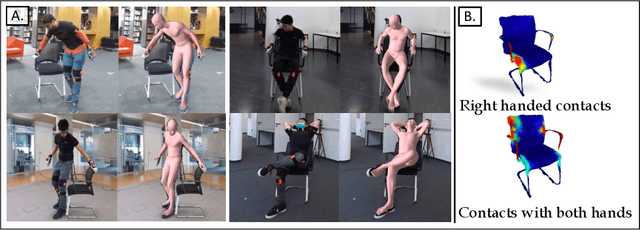


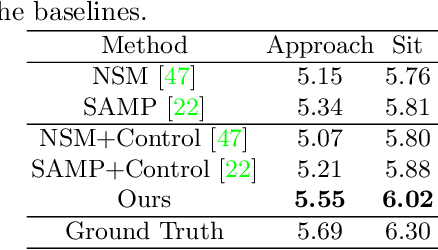
Abstract:Humans interact with an object in many different ways by making contact at different locations, creating a highly complex motion space that can be difficult to learn, particularly when synthesizing such human interactions in a controllable manner. Existing works on synthesizing human scene interaction focus on the high-level control of action but do not consider the fine-grained control of motion. In this work, we study the problem of synthesizing scene interactions conditioned on different contact positions on the object. As a testbed to investigate this new problem, we focus on human-chair interaction as one of the most common actions which exhibit large variability in terms of contacts. We propose a novel synthesis framework COUCH that plans ahead the motion by predicting contact-aware control signals of the hands, which are then used to synthesize contact-conditioned interactions. Furthermore, we contribute a large human-chair interaction dataset with clean annotations, the COUCH Dataset. Our method shows significant quantitative and qualitative improvements over existing methods for human-object interactions. More importantly, our method enables control of the motion through user-specified or automatically predicted contacts.
BEHAVE: Dataset and Method for Tracking Human Object Interactions
Apr 14, 2022

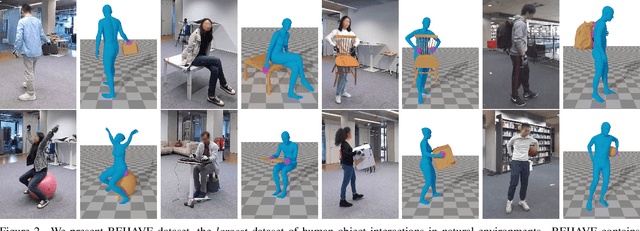
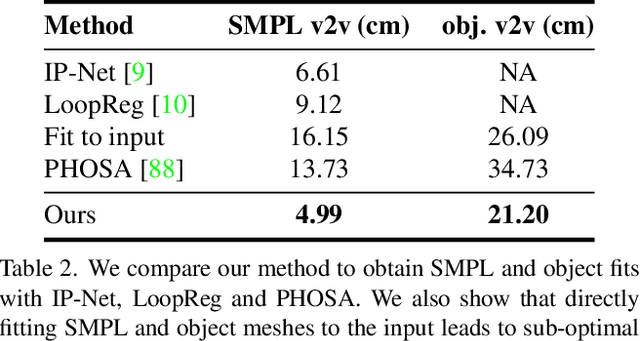
Abstract:Modelling interactions between humans and objects in natural environments is central to many applications including gaming, virtual and mixed reality, as well as human behavior analysis and human-robot collaboration. This challenging operation scenario requires generalization to vast number of objects, scenes, and human actions. Unfortunately, there exist no such dataset. Moreover, this data needs to be acquired in diverse natural environments, which rules out 4D scanners and marker based capture systems. We present BEHAVE dataset, the first full body human- object interaction dataset with multi-view RGBD frames and corresponding 3D SMPL and object fits along with the annotated contacts between them. We record around 15k frames at 5 locations with 8 subjects performing a wide range of interactions with 20 common objects. We use this data to learn a model that can jointly track humans and objects in natural environments with an easy-to-use portable multi-camera setup. Our key insight is to predict correspondences from the human and the object to a statistical body model to obtain human-object contacts during interactions. Our approach can record and track not just the humans and objects but also their interactions, modeled as surface contacts, in 3D. Our code and data can be found at: http://virtualhumans.mpi-inf.mpg.de/behave
* Accepted at CVPR'22
 Add to Chrome
Add to Chrome Add to Firefox
Add to Firefox Add to Edge
Add to Edge